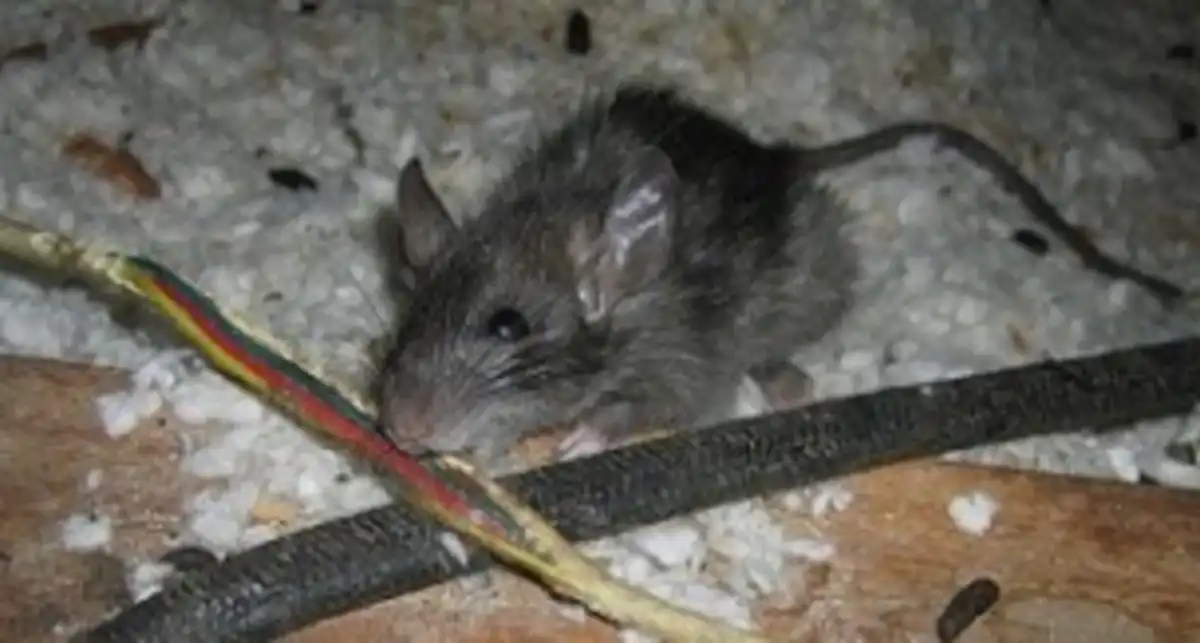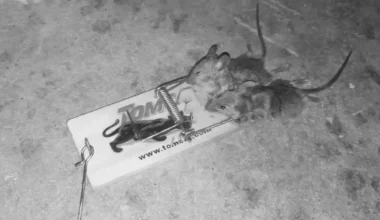As the hottest season of the year arrives in Southern Florida, it’s not just humans seeking relief from the scorching temperatures. Roof rats seek shelter in air-conditioned roofs and attics, invading homes to escape the heat. Regrettably, these rodents do cause significant damage to your residence and you want to get rid of roof rats in Florida.
Traditionally, an effective way to keep these furry intruders out is to prevent them in the first place. But if you’ve already detected signs of rodents, you want to identify the specific species that have taken residence and then remove them.
Identifying roof rats

Roof rats, also referred to as palm rats, fruit rats, ship rats, and Alexandrian rats, can be found under various names. Infestations in homes can occur from both roof rats and Norway rats, with the latter being a more robust type of rat.
Roof rats inhabit the coastal regions of the United States. Unlike their relatives, the Norway rats, they are inclined towards warmer climates, which explains their increasing population in Florida.
Roof rat appearance is characterized by black fur and elongated, slender tails. They feature large, round ears and typically weigh between 5 to 9 ounces, showcasing a sleek physique. Their tail is typically scaly, dark in color, and longer than their head and body combined, 8-10 inches.¹
These agile critters are known for their quickness and exceptional climbing abilities. They have a preference for inhabiting the upper levels of buildings, such as attics, roofs, and top floors.
Being nocturnal rodents, roof rats exhibit peak activity during the nighttime hours. Their diet primarily consists of fruits, berries, nuts, and occasionally meat. If you happen to hear their presence during the daytime, it could be an indication of severe infestation.
How to get rid of roof rats in Florida
While do-it-yourself removal methods may not be as effective as hiring professional rodent control services, there are numerous preventive measures you can take to hinder their invasion and minimize their population in your home. Consider these methods to get rid of roof rats in Florida:
1. Perform a thorough home inspection
The first step involves being observant of signs of roof rats and evaluating the extent of damage in your home. As previously mentioned, the earlier you identify their presence, the sooner you can safeguard your house against potential harm.
Common indications of roof rats include the presence of droppings, grease trails, and behavioral agitation in your pets. Roof rat droppings are typically around half an inch long and have pointed ends. You can sight roof rats scurrying along tree branches and power lines near your roof. That’s why it is advisable to inspect your attic for any signs of intrusion. Look out for droppings, nests, or damage to the insulation and walls. You might also come across remnants of food left behind by the rats.
When retiring for the night, remain attentive to any auditory cues you may hear. You could hear the sounds of roof rats scurrying around within the walls or ceiling.
2. Rat-proof your Florida home
Have you identified how the roof rats are gaining access to your home? Are there any missing shingles or holes in the walls? You can prevent their entry into the attic by blocking off these access points to get rid of roof rats in Florida. Consider repairing your roof and walls and ensure that any cracks or holes are properly sealed.
The objective is to create an environment that makes it tough for roof rats presence. That should make it more likely for them to seek out a new location. You could even use ultrasonic devices to deter roof rats. The device works by emitting frequencies that disturb their ears. However, while some studies show that pest infestations decrease, many others have claimed that there is no way of proving that it was a result of the ultrasonic sound.²
3. Remove their food sources
Roof rats have a preference for seeds, nuts, berries, and insects, especially beetles and cockroaches. So, make sure to introduce a pest control plan that targets these preferred food sources to deter roof rats and discourage them from entering your property altogether.
4. Set rat traps
Placing rat traps can sometimes be perplexing. That’s because you have to determine the most suitable traps and their optimal placement, which can pose difficulties. Moreover, you may question the effectiveness of setting traps when dealing with a substantial roof rat issue. Trapping alone is not a comprehensive solution for controlling a large population of roof rats. However, when dealing with occasional individual rodents passing through, traps can be useful.
You might also want to consider humanity when using traps to get rid of roof rats in Florida. Some people argue that trap types such as glue traps are extremely inhumane due to the “prolonged suffering” of the rodent.³ Others also argue that electronic traps, snap traps, and poisons are equally inhumane since they take the animal’s life. That would make it “reasonable” to consider using live traps, such as no-kill and bucket rat traps. You’d have to check the bucket regularly and release any caught rat at least 100 yards away.
5. Place ultrasonic devices
As already explained, ultrasonic repellents emit non-repetitive, high-frequency sound waves that discourage rats to leave or stop them from entering your residence through the noise. While the sound is unpleasant for rodents, it does not disturb humans or the majority of pets.
Your dogs, cats, and fish are not affected by the sound, although it helps to relocate hamsters or guinea pigs to a different room.
There are a variety of ultrasonic devices to choose from. You can browse through the options in stores or online and select the one that suits the size of your room where it will be used. Regardless of the specific device you choose, ultrasonic devices are typically easy to use—a simple plug and use. There’s often no need for baiting or adjusting settings.
6. Set up electronic traps
Electronic traps are considered a contemporary alternative for dealing with rats in a humane and non-toxic method. These traps employ a high-voltage shock to get rid of roof rats in Florida.
Here are some notable advantages of these indoor-only traps:
- Reusable
- The deceased rat is not visible but can be easily disposed of.
- They feature a blinking light that indicates a successful kill.
- Safe to use around children and pets.
Electronic traps are simple to bait and set. Additionally, disposing of the dead rat is hassle-free, ensuring a clean and mess-free experience. Moreover, electronic traps operate on cell batteries and can provide approximately 60 kills with one set of batteries. Depending on the capacity, they can approximately kill 50 rats per set of batteries.
7. Seek assistance from a pest control professional
Sometimes, merely obstructing access points and deploying snares may not suffice to complete the task. Certain instances of rodent infestations exhibit persistence and a strong resolve to inhabit your roof. In such scenarios, it is advisable to seek the assistance of experts.
Eliminating roof rats permanently demands both tenacity and specialized knowledge. You may not be able to consistently monitor traps in your attic or evaluate the condition of your roof. Fortunately, pest control companies specifically can address this particular issue.
When searching for a rodent control company, prioritize those with extensive experience in dealing with roof rats. Southern Florida is notorious for being infested with these pests, but not all local companies possess equal expertise.
Nesting areas and diets
Unlike other rat species, roof rats are excellent climbers. They can construct nests above ground rather than in underground burrows. When outdoors, roof rats nest in trees, shrubs, woodpiles, and dense vegetation.
While inside homes, they prefer to build nests in elevated areas that retain warmth due to rising heat. You might find roof rat nests in various locations within your home, such as attics, cabinets, ceilings, garages, inside walls and sheetrock, laundry rooms, patios, and pool areas.
Regarding diets, roof rats prefer meat scraps and high-protein foods—they have a diet similar to squirrels. Roof rats primarily eat nuts and fruits, but like all rats, they are omnivorous and will eat a wide range of items when hungry, including cockroaches. Other menu options include:
- Ornamental plants,
- Pet food
- Livestock feed (where they enter your chicken coop, for example)
- Nuts
- Paper
- Garden vegetables
- Seeds
- Candle wax
- Tree bark
- Tomatoes plants
- Insects
- Lizards
- Lemons
Roof rats exhibit hoarding tendencies, storing nuts and seeds in their nests for future consumption. They rely on various water sources such as:
- Irrigation lines
- Bird baths
- Air conditioning condensation drip lines
- Leaky pipes
- Water bowls for pets
- Saucers placed beneath potted plants
Roof rats are known to gnaw through plastic and metal pipes in order to access water, which can result in significant structural damage. Unfortunately, your renters insurance may not cover rat damage.
Signs of a roof rat in your home
Roof rats tend to chew through both plastic and metal pipes in their quest for water, posing a risk of causing severe structural damage.
One clear indication of an infestation is the presence of roof rat droppings, which are smaller compared to those of Norway rats. These droppings typically measure around 0.5 inches in length and have pointed ends.
There are other signs to look out for when determining a roof rat infestation, including:
- Live roof rats scurrying along tree limbs, power lines, patios, rooftops, and fruit trees.
- Audible signs of a roof rat infestation may include hearing gnawing or scratching sounds emanating from the attic or walls.
- The presence of gnaw marks around the roof or eaves of the house.
- If you have fruit trees, one of the signs of a roof rat infestation is finding hollowed-out fruit.
- The presence of a roof rat infestation can cause pets to display signs of stress and agitation.
- Roof rat infestations can result in gnawing damage to electrical wires within the home.
- As roof rats move along their regular paths throughout the home, they may leave behind grease trails and marks.
- Nests in the insulation of your home.
Once indoors, the population of roof rats can multiply swiftly. A female roof rat can have 4 or 5 litters per year, and about 5 to 8 pups are born after a gestation period of 21 to 23 days.⁴
Roof rats are dangerous and destructive
A rat that considers you a threat can become aggressive, resorting to biting or chasing in defense. If a roof rat bites you, it can transmit diseases, such as rat-bite fever, which is transmitted to humans through a bite or scratch.⁵ The symptoms of rat-bite fever typically manifest within a few days to a few weeks after the incident. Sometimes the bite or scratch may have already healed by the time symptoms appear. Below are symptoms according to the CDC⁶:
- Fever
- Headache
- Vomiting
- Muscle pain
- Joint pain or swelling (about 5 in 10 people with RBF have this)
- Rash (takes place in about 3 out of 4 people with RBF)
Note that some diseases transmitted by rodents can be lethal to humans if not treated appropriately.
Rat droppings also spread diseases. Currently, there is no established link between roof rats and Hantavirus pulmonary syndrome. However, be cautious when cleaning up roof rat droppings and urine. Hantavirus is primarily transmitted to humans when they inhale air contaminated by rat saliva, droppings, or urine.
There is also a risk of contracting illnesses from fleas that have previously fed on rats. When a flea bites a rat and subsequently bites a human, it can transmit diseases such as plague and tularemia.
Now, let’s consider property damage. Roof rats frequently experience thirst and actively seek sources of water. Their relentless quest for hydration can lead them to chew through your air conditioner drip lines, irrigation lines, and even pipes. The sharp teeth of roof rats make short work of both plastic and metal materials.
Roof rats can build their nests by either burrowing into your home’s insulation or removing sections of insulation to create their nests in alternative locations. They often also gnaw on electrical wires, drywall, and roof eaves.
Ultimately, you want to keep your house free from roof rats for a comfortable indoor environment during the summer while retaining cool air in your Florida home. Do not hesitate to contact your local pest control professional to handle a high infestation.
- Roof Rat Identification. Maricopa County
- Sonic Pest Repellents. College Of Agriculture & Life Sciences Cooperative Extension
- Glue Traps: Pans of Pain. PETA
- Control of Roof Rats in Fruit Trees. University of Florida
- Rat-bite Fever (RBF). CDC
- Signs and Symptoms. CDC






